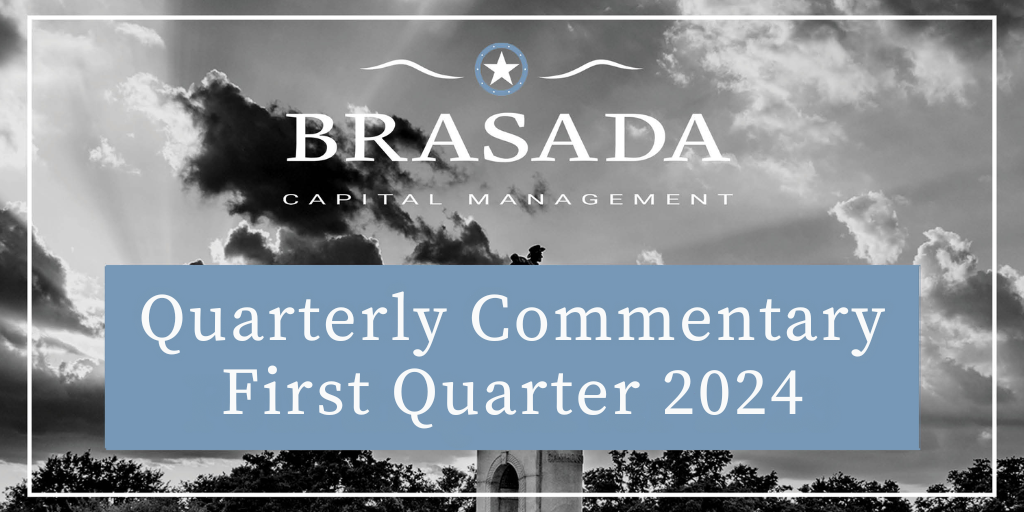First Quarter of 2024
2023: Lessons Learned Last year can best be characterized as a year of surprising resilience. Consider that despite high inflation, hawkish Fed...

“The single greatest edge an investor can have is a long-term orientation.” - Seth Klarman
“Only by looking further out than the short-term crowd can we expect to beat them.” - Nick Sleep
"The most profitable kind of investing is long term investing." - Li Lu
Wall Street’s Love Affair with Short-Termism
Most of us have a basic understanding that the future is uncertain. Maybe the stock market will crash tomorrow, or maybe a war will break out somewhere, or maybe there will be a global pandemic. We know that more things can happen tomorrow than will. However, when we look back at yesterday, all we tend to see is certainty. We see the events that happened, and we assume that they were the only events that could have ever happened. In hindsight, everything seems obvious, and we construct explanations post hoc for why it was obvious. Over time, this backward sense-making starts to filter into how we see the future.
An event could have been completely random, but we will still try and construct a reason for why it happened. This tendency – to find patterns where none exist – is ingrained in our nature. If that swaying grass turned out to be a lion, and our ancestors didn’t run, it would have been game over for them. However, in today’s world, that mechanism of overconfident prediction often gets us into more trouble than it is worth. The roulette wheel landed on red 5 times in a row. Black is guaranteed to be next. The price of oil keeps dropping, it is due to go up. Pattern X will lead to outcome Y since it has in the past.
A whole industry of TV commentators and sell side analysts have been built up to take advantage of this inherent unwillingness to accept uncertainty. Unfortunately, these modern-day forecasters are often no more useful than the soothsayers and oracles that came before them.
Short-term prediction is nearly impossible to get right (just look at the number of commentators predicting a recession last year). So then why does it feel like every time we turn on CNBC there is a pundit telling us exactly what will happen in the next three months? Basically, if there is a market for something, someone will supply it, and there happens to be a huge market for short-term predictions. This demand incentivizes pundits to continue making those predictions whether they are accurate or not, and lucky for them, most people quickly forget their wrong predictions, and only remember their right predictions. As the saying goes, even a broken clock is right twice a day.
In the same way TV pundits sell short-term predictions to retail investors, Wall Street analysts sell short-term predictions to institutional investors. Consider that most investment firms place far too much focus on short-term performance, and even place targets on fund managers to not significantly underperform an index or peer group, even over a period as short as a quarter. This leads to well-known negative effects such as higher turnover, which generate fees and taxes. To avoid career risk, these investment firms often end up chasing the market. They sell during panics and buy during booms, which is the exact opposite of what a rational long-term investor should be doing.
Luckily for us, this consistent overweighting of the short-term by Wall Street creates plenty of opportunities for anyone that can take a longer-term view. That is what we would like to discuss with in today’s commentary: The importance of Long-term thinking.
Long-term Thinking: An Investing Superpower
When we really drill down on it, stock values are determined by only two factors:
For example, pretend we knew for certain that a company was going to generate $2.00 in earnings per share every year until the end of time. Those are the fundamentals. And let’s assume the market is willing to pay 20x one year’s earnings for the company. Combine the two ($2.00 in earnings x 20x earnings multiple) and the stock price will be $40.
So, we buy at $40 and print our 5% earnings yield ($2 earnings on $40 stock price) till the end of time. Simple enough right? Unfortunately, not. The fundamentals here may be constant in our example, but the sentiment is largely unpredictable. Rather, whether a stock trades at a 20x or a 10x multiple is decided by thousands of market participants who are known for acting irrationally. They herd, panic, get overly greedy, get overly fearful, and generally do a poor job of determining actual value in the short term.
Say the market does decide our $2.00 earnings stream is only worth 10x rather than 20x. There are a lot of reasons this could happen. Maybe the market doesn’t think that $2.00 of earnings is sustainable long term, or maybe the market thinks there are better opportunities elsewhere, or maybe that company or ‘style’ is just out of favor this month. For whatever reason, we just lost 50% of our fundamentally certain investment.
We basically have two options at this point:
Often if the multiple gets cut in half due to short-term sentiment shifts, it can often turn out to be a great buying opportunity.
Recent Case Studies in Long-Term Thinking
We don’t have to look back too far to find a great example of the power of long-term thinking. Recall that just four years ago the market sold off ~35% in the span of a few weeks during the onset of the Covid-19 pandemic.
At the time, the market was doing what it usually does and extrapolating the current status quo far into the future. “Things are bad today, and therefore things must be bad tomorrow.” The sell off was magnified by so called “Passive Investors” that decided to make the active choice to sell their funds at the worst possible time.
Recall that during periods of extreme emotional stress, many passive investors (and even many professional investors) will panic sell out of the market at which point their index provider (usually an ETF) must sell all the underlying stocks that are in that passive product to give the investor their cash back. Both the good and the bad businesses are sold indiscriminately during this process, hence the opportunity for a long-term investor to step in and acquire great bargains.
Now, not to downplay the uncertainty during those early days in March 2020, but the truth is that we live with uncertainty every single day of our lives. For example, since just the great recession, the markets have been tested almost annually by some crisis of uncertainty or another: Elections, Greek Default, Brexit, Flash Crashes, Oil Crashes, Banking Panics, Trade Wars, Actual Wars, and more. At each turn, there were lots of investors that threw in the towel thinking they could time the market (to their detriment).
Any investor that could take a longer-term view during these crises would take comfort in the fact that 100% of all past crises have proven to be good buying opportunities. The reason for this is twofold: firstly, humanity is really, really good at adapting to adversity. And secondly, as stock prices go down, their forward returns go up (this is basic math that short-term investors always forget!).
It is also important to point out that the power of long-term thinking works during periods of market booms as well as during market panics. In the same way markets can extrapolate bad news into the future, they can often do the same for good news (think the current optimism around AI). As we see pockets of irrational exuberance forming in asset markets, the long-term investor’s preferred strategy will always be to simply avoid them, and instead focus on where they can find more defensible value for the long run.
As we mentioned earlier, much of our industry is happy to ride these waves of irrational exuberance for as long as they can, and they might feel vindicated as they see the price of their holdings go straight up, but just because the price is going up, does not mean that the value is going up. In the long run, value is the measure that always wins out and often these strategies end up simply taking ever-more risk to chase ever-lower returns. It works until it doesn’t.
Conclusion
Stock prices are driven by two things: short-term sentiment and long-term fundamentals.
Even if we could predict economic and geopolitical events with any degree of accuracy, we still wouldn’t be able to predict how the market would respond to those events. But we can predict the economic fundamentals of businesses to varying degrees. If we think a company is going to generate a roughly 10% cash earnings CAGR over the next few decades, it doesn't matter if the stock gets cut in half in any given year, long-term investor returns will track that 10% earnings growth.
And more importantly, if the market ever sells off a high-quality business for short-term issues, it provides us with the opportunity to initiate a stake in that business at the same time the rest of the market is selling it off.
For us, that is the true value of long-term thinking, arbitraging the difference between short-term sentiment shifts and long-term business fundamentals.

2023: Lessons Learned Last year can best be characterized as a year of surprising resilience. Consider that despite high inflation, hawkish Fed...

“The single greatest edge an investor can have is a long-term orientation.” - Seth Klarman “Only by looking further out than the short-term crowd...

We're delighted to share with you a replay of Brasada Capital Management’s Annual Client and Friends Dinner. Each year this event stands out as a...